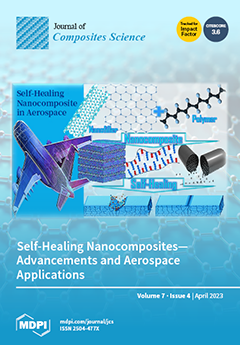Nowadays, companies and researchers are concerned about the negative consequences of using synthetic polymers and direct their efforts to create new alternatives such as biocomposites. This study investigated the effect of biobased SiO
on the properties of poly(L-lactic acid)/SiO
(PLLA/SiO
[...] Read more.
Nowadays, companies and researchers are concerned about the negative consequences of using synthetic polymers and direct their efforts to create new alternatives such as biocomposites. This study investigated the effect of biobased SiO
on the properties of poly(L-lactic acid)/SiO
(PLLA/SiO
) and poly(L-lactic acid)/SiO
/poly(ethylene glycol) (PLLA/SiO
/PEG) composites. The SiO
was obtained from rice husk incineration and mixed with PLLA at various concentrations (5, 10, and 15 wt.%) via melt extrusion before compression molding. Furthermore, PLLA/SiO
/PEG composites with various PEG concentrations (0, 3, 5, and 10 wt.%) with 10 wt.% SiO
were produced. The sample morphology was studied by scanning electron microscopy (SEM) to analyze the dispersion/adhesion of SiO
in the polymer matrix and differential scanning calorimetry (DSC) was used under isothermal and non-isothermal conditions to study the thermal properties of the samples, which was complemented by thermal stability study using thermogravimetric analysis (TGA). Rheological analysis was performed to investigate the viscoelastic behavior of the composites in the melt state. At the same time, tensile mechanical properties were obtained at room temperature to determine their properties in the solid state. DSC and X-ray diffraction analysis (XRD) were combined to determine the crystalline state of the samples. Finally, gas permeation measurements were performed using a variable pressure (constant volume) method to analyze the permeability of different gases (CO
, CH
, O
, and H
). The results showed that SiO
decreased the PLLA chain mobility, slowing the crystallization process and lowering the gas permeability while increasing Young’s modulus, thermal stability, and viscosity. However, PEG addition increased the crystallization rate compared to the neat PLLA (+40%), and its elongation at break (+26%), leading to more flexible/ductile samples. Due to improved silica dispersion and PLLA chain mobility, the material’s viscosity and gas permeability (+50%) were also improved with PEG addition. This research uses material considered as waste to improve the properties of PLA, obtaining a material with the potential to be used for packaging.
Full article





